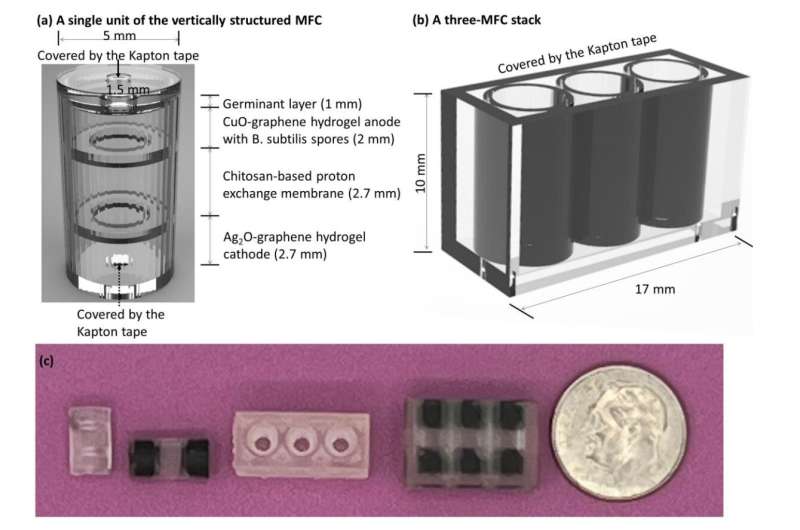This article has been reviewed according to Science X's editorial process and policies. Editors have highlighted the following attributes while ensuring the content's credibility:
fact-checked
peer-reviewed publication
trusted source
proofread
Tiny biobattery with potential 100-year shelf life runs on bacteria

Last fall, Professor Seokheun "Sean" Choi and his Bioelectronics and Microsystems Laboratory published their research into an ingestible biobattery activated by the Ph factor of the human intestine.
Now, he and Ph.D. student Maryam Rezaie have taken what they learned and incorporated it into new ideas for use outside the body.
A new study in the journal Small shares the results from using spore-forming bacteria similar to the previous ingestible version to create a device that potentially would still work after 100 years.
"The overall objective is to develop a microbial fuel cell that can be stored for a relatively long period without degradation of biocatalytic activity and also can be rapidly activated by absorbing moisture from the air," said Choi, a faculty member in the Department of Electrical and Computer Engineering at the Thomas J. Watson College of Engineering and Applied Science.
"We wanted to make these biobatteries for portable, storable and on-demand power generation capabilities," Choi said. "The problem is, how can we provide the long-term storage of bacteria until used? And if that is possible, then how would you provide on-demand battery activation for rapid and easy power generation? And how would you improve the power?"
The dime-sized fuel cell was sealed with a piece of Kapton tape, a material that can withstand temperatures from -500 to 750 degrees Fahrenheit. When the tape was removed and moisture allowed in, the bacteria mixed with a chemical germinant that encouraged the microbes to produce spores. The energy from that reaction produced enough to power an LED, a digital thermometer or a small clock.
Heat activation of the bacterial spores cut the time to full power from 1 hour to 20 minutes, and increasing the humidity led to higher electrical output. After a week of storage at room temperature, there was only a 2% drop in power generation.
While these are all good results, Choi knows that a fuel cell like this needs to power up more quickly and produce more voltage to become a viable alternative to traditional batteries.
"I think this is a good start," he said. "Hopefully, we can make a commercial product using these ideas."
More information: Maryam Rezaie et al, Moisture‐Enabled Germination of Heat‐Activated Bacillus Endospores for Rapid and Practical Bioelectricity Generation: Toward Portable, Storable Bacteria‐Powered Biobatteries, Small (2023). DOI: 10.1002/smll.202301135
Journal information: Small
Provided by Binghamton University




















